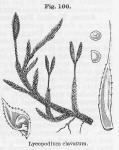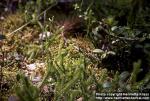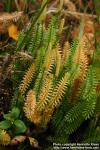
 "The spores of Lycopodium clavatum, Linné, and of other species of Lycopodium"—(U. S. P.).
"The spores of Lycopodium clavatum, Linné, and of other species of Lycopodium"—(U. S. P.).
Nat. Ord.—Lycopodiaceae.
COMMON NAMES AND SYNONYM: (Plant) Club moss; (Spores) Lycopodium seed, Pulverized lycopodium, Vegetable sulphur, Sporae lycopodii.
ILLUSTRATION: Bentley and Trimen, Med. Plants, 299.
Botanical Source.—Club moss is a creeping perennial with a trailing stem, giving off several ascending leafy branches. The stem is often several feet in length and thickly clothed with lance-linear, awl-shaped, smooth, flat, evergreen leaves, which are imbricated and inflexed. The branches are from 2 to 4 inches high, the fertile ones having a long, terminal peduncle supporting from 1 to 3 erect, long, cylindrical flower spikes which are clothed with ovate, sharp-pointed bracts, bearing in their axils the yellow reniform sporangia (thecae).
History.—Lycopodium, or Common club moss, is found in almost all parts of the earth, especially in northern regions, growing in dry situations, as pastures, mountains, and woods. The spores, the chief medicinal portion, are shaken out of the renal-shaped capsules (sporangia) which grow on "the inner side of the bracts covering the fruit spike" (Pharmacographia) as a yellowish powder. The drug is gathered in Germany, Russia, and Switzerland, during the months of July and August, by the peasants, who cut the tops from the plants and carry them to their homes, where the powder is obtained by shaking the tops and sifting out the extraneous matter. As the plant fails to be plentiful some years, the annual collection is apt to vary much.
Description.—According to the U. S. P., lycopodium is "a fine powder, pale, yellowish, very mobile, inodorous, tasteless, floating upon water and not wetted by it, but sinking on being boiled with it, and burning quickly when thrown into a flame. Under the microscope the spores are seen to be sphaero-tetrahedral, the surfaces marked with reticulated ridges, and the edges beset with short projections. Lycopodium should be free from pollen, starch, sand, and other impurities, any of which are easily detected by means of the microscope. When ignited with free access of air, lycopodium should not leave more than 5 per cent of ash"—(U. S. P.).
If lycopodium be heated slowly it burns with violence, but if brought in contact with a flame, it suddenly catches fire with a vivid flash and a hissing explosiveness. Unlike most bodies, when triturated it becomes darker in color, assuming a somewhat greasy and coherent state. When dried at 100° C. (212° F.), it loses but 4 per cent of moisture (Pharmacographia).
Chemical Composition.—Sugar to the extent of 3 per cent (Langer, 1889, 2.1 per cent), was found in lycopodium by Bucholz (1807). Pollenin is the name applied to the material composing the walls of the cells. Alfons Langer (Archiv der Pharm., 1889, pp. 241, 289, and 625), obtained from the spores of commercial Lycopodium clavatum 49.34 per cent of a greenish-yellow oil having an acid reaction and consisting of about 80 to 86.6 per cent of a peculiar lycopodium-oleic acid (C16H30O2 or [CH3]2CH.CH.CH.C[CH2].(CH2)9.COOH, decyl-isopropyl acrylic acid), with varying quantities of glycerin (about 3 to 5 per cent), and solid fatty acids, chiefly myristic acid. The spores must be powdered by trituration with quartz-sand if all of the oil is to be extracted (Pharmacographia). A. Bukowski (Archiv der Pharm., 1889, p. 625), analysing freshly collected spores, obtained an oil of neutral reaction, and a constant quantity (8.2 per cent) of glycerin. It also differed in chemical composition from that obtained by Langer. The latter found the spores to contain 0.857 per cent of nitrogen, corresponding to 5.3 per cent of protein substance. When heated with solution of caustic potash, the spores yielded monomethylamine (CH3NH2). Upon being incinerated, they gave 1.16 per cent of ash. The spores have the peculiar property of oxidizing a portion of the alcohol with which they are macerated, to aldehyde.
Adulterations.—Besides the possible adulterants mentioned by the U. S. P., dextrin and spores of other species of Lycopodium, gypsum, talc, sulphur, and rosin may be present. According to A. L. Reichert (Pharm. Review, 1898, p. 260), most of the specimens of lycopodium examined were practically free from adulteration, containing mostly fragments of the sporangium wall as impurities; one specimen contained 20 per cent of pine pollen, and two other specimens had potato starch, in one amounting to 30 per cent.
Action, Medical Uses, and Dosage.—This agent was for a long time used only as a dusting powder for protective purposes in erysipelas, intertrigo, herpes, ulcers, eczemas, etc. Druggists used it to prevent pills from adhering to each other in the boxes, and pyrotechnists employed it in the manufacture of their wares. Of recent years it has become quite important as a remedy in our school, the suggestion coming first from the homoeopaths, who use it quite extensively. It was introduced to us as a remedy by Prof. Scudder. He prepared a tincture of the fresh plant before it had cast its sporules with 98 per cent alcohol, and also a tincture of the sporules first triturated in a dry mortar until doughy, then placing them in a percolator, covering with alcohol, allowing to macerate 4 days, when the tincture was drawn off. He recommended the tincture of the sporules in "extreme sensitiveness of the surface; sensitiveness of a part, and care to prevent its being touched; slow, painful boils; nodes or swellings; extreme sensitiveness of the organs of special sense, with pale, livid, or dirty complexion" (Spec. Med. 174) (I can't find it. Perhaps it's in a later edition. -Henriette)
In fevers showing an obscure periodicity lycopodium has been found curative. The cases are not distinctly agues nor ordinary intermittents, and consequently not influenced by quinine. The febrile phenomena are not active, and there may be an irritable stomach, with either diarrhoea, dysentery, or constipation, an obscure colic being associated with the latter, and some sore throat. The fever, though not active, is intractable, and exceedingly depressing, and the characteristic symptoms guiding the selection of lycopodium are a high-colored red urine staining the clothing, and an afternoon exacerbation, usually occurring in the middle of the afternoon.
Lycopodium is an efficient gastric sedative, and with the high-colored red urine, and the patient suffering more in the afternoon, will be found of value in dyspepsia, and especially if constipation and cardiac palpitation are also present. There is tenderness over the stomach and a sense of fullness. Pyrosis, with flatulence, is corrected by it, and in indigestion, with fermentative changes and borborygmus, it should be remembered when the special indications above alluded to are present. It is reputed useful in catarrhal gastritis.
Lycopodium is prominent as a remedy in urinary disorders. Spasmodic retention of urine in children, and catarrhal cystitis in adults, with deposits of mucus or mucus and blood, with frequent painful micturition, are disorders in which it has rendered good service. It is a remedy for the lithic acid diathesis, when there is pain in the kidneys, ureters, and bladder, with unpleasant sensations in micturition, and there are red, sandy deposits in the urine. Gonorrhoea, gleet, vesical catarrh, and rheumatism with uric acid diathesis, are said to be benefited by lycopodium. Dr. Scudder recommended the tincture of the plant in chronic kidney diseases with blood in the urine; and in cases of "cough with bloody expectoration, congestive headache, dizziness, and tendency to syncope." The usual method of administering lycopodium for its specific effects is as follows: Rx Specific lycopodium, gtt. x; aqua, fl℥iv. Mix. Sig. Dose, a teaspoonful every 1 or 2 hours.
Specific Indications and Uses.—Intractable forms of fever, not of an active type, showing obscure periodicity, with afternoon exacerbation, and the voiding of a high-colored red urine, staining the clothing; dyspepsia and indigestion with the same urinary symptoms, or with red, sandy deposits in the urine, palpitation, constipation, borborygmus, and water brash; spasmodic retention of urine in children; cystic catarrh in adults, with painful micturition; urine loaded with mucus or blood, or both, or deposits of red sand or phosphates; cough with bloody expectoration, congestive headache, dizziness, and tendency to fainting.
 Related Species.—There are several varieties of Lycopodium whose spores are sometimes collected with those of L. clavatum. Among them may be mentioned the Lycopodiums—innundatum, complanatum, and annotinum—of Linnaeus. An alkaloid lycopodine (C32H52N2O3) was obtained from L. complanatum by K. Boedeker (1882).
Related Species.—There are several varieties of Lycopodium whose spores are sometimes collected with those of L. clavatum. Among them may be mentioned the Lycopodiums—innundatum, complanatum, and annotinum—of Linnaeus. An alkaloid lycopodine (C32H52N2O3) was obtained from L. complanatum by K. Boedeker (1882).
Lycopodium saururus. This plant is the Piligan of Brazil. Piliganine, a toxic alkaloid not identical with the above lycopodine, was discovered in it by Adrian (Jahresb. der Pharm., 1886 and 1892). A dog succumbed to 2 grains of this alkaloid, which is said to possess emeto-cathartic, and convulsant properties. The plant likewise acts as an emeto-cathartic, doses of 4 grains of the extract producing purgation. As a cathartic, piliganine hydrochlorate maybe administered in doses of from 1/6 to 1/3 grain.

